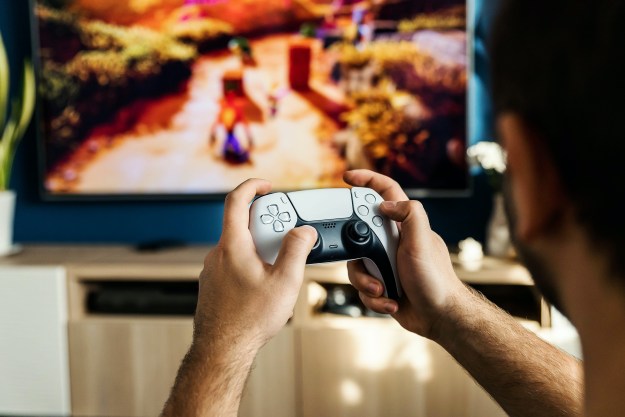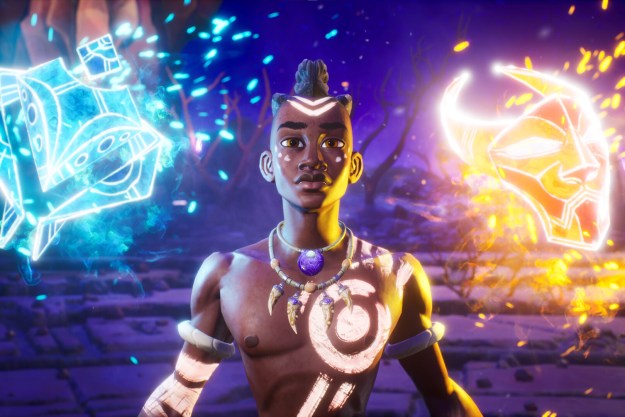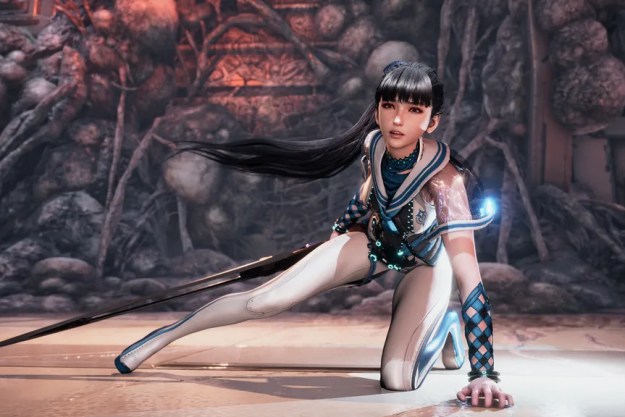While the Nintendo Switch isn’t a powerhouse console like the PlayStation 4, it more than makes up for it with its portability. However, Sony is preparing to launch the PlayStation 5 very soon, widening the technological gap between the two systems. The PS5 certainly isn’t portable — in fact, it will be one of the largest consoles ever made — but that massive footprint is backed up by some serious horsepower.
Sony has also announced that the PS5 will be sold in two varieties, with one of them lacking an optical drive and requiring digital downloads. As the video game industry shifts to an all-digital ecosystem, this disc-less PS5 starts to make more sense — especially coming in at $100 less expensive than the standard edition.
Despite the obvious leap in power and lightning-fast load times with the PS5, the Nintendo Switch is an excellent choice for a lot of different reasons. Oftentimes, consumers opt to buy a Nintendo console as a secondary device along with a modern system like the PS5 — allowing them to play all the newest third-party games, without missing out on Nintendo’s superb lineup (and portability). Still, how big is the gap between the two machines?
Here, we’ll compare the two, highlighting the specs of each, pros, cons, and of course, their games.
See more
Specs
PlayStation 5
|
Nintendo Switch |
|
| Dimensions | 15.4 x 10.24 x 4.09 inches | 10 x 4.2 x 0.5 inches |
| Weight | 9.9 pounds | 0.65 pounds |
| Color | White and black | Neon red and blue |
| CPU | AMD Zen 2-based, 8 cores @ 3.5GHz | Nvidia-customized Tegra, shared with GPU |
| GPU | Radeon Navi, 10.28 TFLOPS, ray tracing supported | Nvidia-customized Tegra, shared with CPU |
| Memory | 16GB GDDR6/256-bit | 4GB |
| Memory bandwidth | 448GB/s | 25.6GB/s |
| Storage | 825GB SSD, expandable | 32GB, support for external cards. |
| Optical drive | 4K UHD Blu-ray or digital only | No |
| Max resolution | 8K | 720p handheld, 1080p docked |
| HDR | Yes | No |
| Ports | USB, USB-C, ethernet | HDMI out, One USB-C, One USB 3.0, Two USB 2.0 |
| Online subscription | PS Plus at $60 per year | Nintendo Switch Online at $20 per year |
| Price | Digital — $400, Standard — $500 | $300 |
| Availability | November 12, 2020 | |
| Digital Trends review | Coming soon | 4 out of 5 stars |
The main thing that sticks out with the specs of each system is that the Nintendo Switch is severely underpowered, comparatively speaking. The PS5’s shining force is its solid-state drive (SSD), which allows games to load faster than ever before. The shift to the SSD is huge and will streamline gaming as we know it. We’ve already seen how beautiful some of the upcoming PS5 games look — like Demon’s Souls or Marvel’s Spider-Man: Miles Morales. These games will not only look stunning, but with virtually no load times, you’ll be able to spend more time playing and less time waiting.
With the Nintendo Switch, power isn’t a focus at all. Nintendo is home to masterminds who can extract every ounce of power from the system — bringing together gorgeous games like The Legend of Zelda: Breath of the Wild or Super Mario Odyssey. These games look and run incredibly well and are a testament to how well Nintendo knows its machine (along with non-realistic art directions that are much easier to render). As for third-party games, the results are hit or miss. Typically, the Switch version of a third-party release will almost always look and run worse, simply due to the lack of power. Third-party developers do what they can, and it’s a miracle games like The Witcher 3: Wild Hunt — Complete Edition or Doom (2016) run on the machine at all.
The crux of the comparison comes down to portability versus power. Being able to migrate fully fledged Nintendo games from a big screen to a portable device is a huge asset — and one that consumers have taken to, especially given the Nintendo Switch’s meteoric sales figures (of around 65 million consoles sold in just over three years) thus far. It is worth noting that many of the biggest franchises like Call of Duty, Madden, modern Resident Evil titles, newer Final Fantasy games, Grand Theft Auto, and open-world Ubisoft adventures like Assassin’s Creed will usually skip Nintendo Switch due to its lack of power. The inability to play these popular games practically guarantees that a consumer will pick up a modern system, while using the Switch as a secondary device.
Performance

The Nintendo Switch is not a powerhouse by any stretch of the imagination. It can run games originally meant for systems like the Xbox 360 or Wii U without any issue, and can even offer smoother performance over the original versions. However, the system is not capable of offering performance anywhere close to that of the Xbox One or PlayStation 4 — let alone the consoles that will soon follow. This is especially true when playing third-party games on Nintendo Switch. Doom is perfectly playable on the system, but compared to the other consoles, its frame rate is reduced and its textures are quite muddy.
The Nintendo Switch can display games in two different resolutions, depending on whether or not it is docked. If docked and displaying games to a television screen, the Switch can play games at 1080p resolution. This is the maximum resolution it is capable of producing, and certain games will not be able to reach this number. The new Nintendo Switch Lite system cannot be docked, and can only play games at the standard 720p handheld resolution.
When played with the Switch’s own screen, the resolution is capped at 720p. Given the size of the screen, it is virtually impossible to tell it has been lowered, but the numbers are what they are. The system can also hit 60 frames per second in certain games.

The PS5 will be able to achieve performance the Nintendo Switch could only dream of. In an interview with Wired, lead system architect Mark Cerny shared that the system would be capable of 8K resolution, despite the PlayStation 4 Pro only being able to achieve true 4K resolution in a handful of games. The system will also drastically reduce loading times compared to the PS4, thanks to a solid-state drive instead of a traditional hard drive.
We’ve heard reports of virtually no load times with games like Demon’s Souls, while displaying in 4K — a feat the Switch is not capable of. The PS5 will also have support for ray tracing, which is a graphical feature typically only found in high-end PC systems. This suggests that it will be a larger leap over the PS4 than the PS4 was over the PS3.
An upgraded Switch
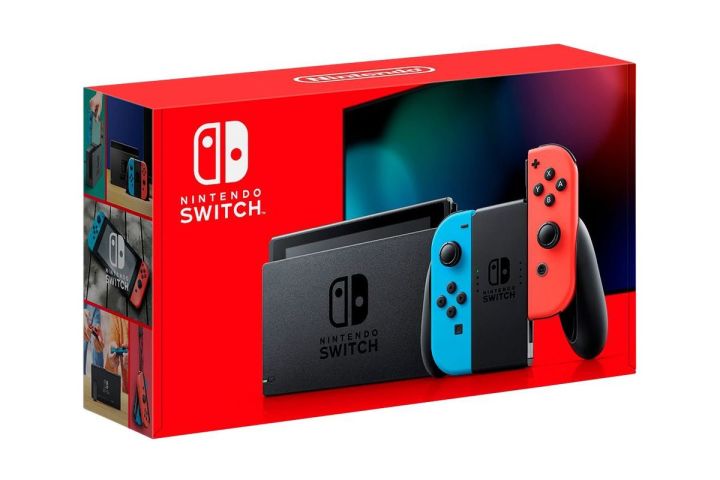
The standard Nintendo Switch found in stores is no longer identical to the one available at launch in 2017. It underwent an internal refreshment without becoming an official second model, with the battery life getting a major boost. This was not a result of a different battery for the system, but rather a more efficient Tegra X1 chip. Slight performance improvements have been reported in certain games, as well as a slightly different tint to the display, but the increased three or so hours of battery life is the real selling point here.
You can tell which one you have by looking at the model number. The newer Switch systems have the model number HAC-001(-01), while the older versions include the model number HAC-001. Each features different packaging, as well. The newer systems come in an all-red box like the one shown above, while the older models were available in a white and red box.
Storage

The Nintendo Switch comes with just 32GB of flash storage on the console itself, which is not even enough to completely install digital versions of certain games. If you purchase physical cartridges for the system, only a small portion of the game must be installed onto the machine, while the rest will run directly from the card itself. The Switch is the only modern game system that doesn’t make use of discs and is the only system that does not force you to install games before playing them.
If you need more storage space, the Nintendo Switch also supports microSDXC cards, which can potentially raise its capacity to 512GB or more. These aren’t cheap, however, and have to be factored into the cost of the system when purchasing.
If you’re concerned about losing access to your precious game save data, you can rest easy. A Nintendo Switch Online membership gives players access to cloud saves and game data backups, which are done automatically when the system is asleep. It should be mentioned, however, that if you decide to cancel your Nintendo Switch Online membership, you will lose access to your cloud save data until you start your membership again, and if that doesn’t happen within six months, your data will be deleted permanently. You can instead manually maintain your own backups of game save data by transferring updated copies of it to a PC, but for some people, that can be tedious. Keep in mind, certain games with multiplayer components, like Animal Crossing: New Horizons and Dark Souls Remastered, do not support cloud saves.
Sony has announced that the PS5 will include an 825GB solid-state drive that will allow for faster loading speeds. PS5 game save data works similarly to the PS4’s — PS Plus subscribers will have access to cloud game saves, as well as game data backups that are performed when the system is asleep. Similar to the Nintendo Switch, if you decide to cancel your PS Plus subscription, you will lose access to your cloud saves and data until you resubscribe, and if six months lapse before that time, the data will be deleted forever. The alternative option to this is keeping all of your save data on a USB storage device, but that also has its risks.
Nonetheless, storage is a major factor, and each system has its pros and cons for how memory is handled. On one hand, the Switch’s storage is much easier to expand, as micro SD cards are less expensive and more ubiquitous, making them easier to find. The PS5 does feature the ultra-fast SSD, but the drives required for an expansion aren’t readily available to consumers yet — and will be expensive when they are more abundant.
Cloud-based Switch games could tighten the gap of power

What if Nintendo could deliver more graphically intensive games — not by releasing enhanced hardware, but by using the cloud? This may very well be one of the solutions to the company’s biggest issue, and Nintendo is already dipping its toes into cloud-based games. In a recent Nintendo Direct, Control: Ultimate Edition Cloud Version was announced and released the same day, bringing one of the most visually stunning games of the generation to the Nintendo Switch thanks to the cloud. You can currently try the first 10 minutes of the game for free so you can test to see if your internet is capable of running the game. It was also announced that the upcoming Hitman 3 will also come to Nintendo Switch via the cloud — another game that would not be able to run on the system natively.
It works like Netflix or other streaming services, wherein the product itself — in this case, a game — is running from an external server and streamed to your device, taking away the need for a powerful machine at home. Based on our test of Control, it works remarkably well — with no noticeable latency or input lag — provided you have a stable internet connection. Therein lies the main downside of this solution. You must be connected to the internet at all times to run these games, which can be more difficult depending on your location. Many rural locations in the United States and elsewhere still have less than reliable internet connections, making it impossible to play any cloud-based games.
In its current state, Nintendo seems to be testing the waters with cloud-based games. It’s unclear what the company’s plans are going forward, but we could very well see modern third-party games release on Switch alongside contemporary consoles like the PS5, thanks to the power of the cloud. It’s an interesting solution, but one that could very well be the future of how games are played.
Game selection

The Nintendo Switch has amassed an impressive game library over the more than three years it has been available, with first-party exclusives as well as third-party games that released alongside other consoles or PC. Among the best first-party and second-party games available on the system are:
- Animal Crossing: New Horizons
- Super Mario Odyssey
- The Legend of Zelda: Breath of the Wild
- Splatoon 2
- Mario + Rabbids Kingdom Battle
- Yoshi’s Crafted World
- Super Smash Bros. Ultimate
- Pokémon: Let’s Go
- Pokémon Sword and Shield
- Fire Emblem: Three Houses
Great third-party games ported from other systems or released simultaneously include:
- The Witcher 3: Wild Hunt — Complete Edition
- Doom
- Wolfenstein II: The New Colossus
- Katana Zero
- Mortal Kombat 11
- Dark Souls Remastered
- Fortnite
- Cuphead
And the Nintendo Switch still has the promise of great-looking games from first- and third-party studios:
- Hyrule Warriors: Age of Calamity
- Immortals Fenyx Rising
- Super Mario 3D World and Bowser’s Fury
- Bravely Default II
- Monster Hunter: Rise
- Monster Hunter Stories 2: Wings of Ruin
- New Pokémon Snap
- Breath of the Wild sequel
- Bayonetta 3
- Metroid Prime 4

The PS5 also has a robust lineup of exclusive titles that will be launching over the next few years, including:
- Horizon Forbidden West
- Ratchet and Clank: Rift Apart
- Demon’s Souls
- Sackboy: A Big Adventure
- Gran Turismo 7
- Marvel’s Spider-Man: Miles Morales
- Godfall
- Deathloop
- God of War: Ragnarok
It will also see its fair share of third-party titles that probably won’t be landing on the Switch:
- Resident Evil Village
- Ghostwire: Tokyo
- Kena: Bridge of Spirits
At the end of the day, both platforms have a fantastic library of games, ranging from family-friendly platformers to gritty action games with adult themes.
Backward compatibility

When it comes to backward compatibility, the PS5 looks to be the clear winner. Sony said it will support backward compatibility for most PS4 games, as well as PlayStation VR titles. The system will also be compatible with the current PlayStation VR headset to play these games. A new version of the PlayStation VR headset is likely coming as well and could use finger-tracking controllers in place of PlayStation Move.
Sony recently confirmed that 99% of PS4 games will work on PS5, with the exception of a handful of titles. The list of games that will not be backward compatible from PS4 to PS5 are as follows:
- DWVR
- Afro Samurai 2 Revenge of Kuma Volume One
- TT Isle of Man — Ride on the Edge 2
- Just Deal With It!
- Shadow Complex Remastered
- Robinson: The Journey
- We Sing
- Hitman Go: Definitive Edition
- Shadwen
- Joe’s Diner
There have been reports that an additional list of PS4 Ubisoft games won’t work on PS5, but the publisher recanted, stating that its published list contained “inaccuracies,” and that the correct list would be updated soon. Some games on the list included many older Assassin’s Creed titles.
The Nintendo Switch doesn’t support backward compatibility with any games you purchased for other Nintendo systems. As it doesn’t have the “Virtual Console” store like the Wii U, 3DS, and Wii, you cannot play those games on the Switch. As mentioned previously, you can find ports of certain older Nintendo games on the Switch, but they are typically priced at around $60, which is often a tough pill to swallow. It’s unclear if Nintendo will offer a solution to backward compatibility, but as it stands, if you want to play many games released before the Switch, you’ll need to bust out older systems.
Online services

With Nintendo Switch Online, which can be purchased annually for $20, you are given access to the ability to play multiplayer games online. The feature was previously free with the console, but is now integrated into a paid service. You are also given access to cloud game save backup, as mentioned above, and you can play games in the Nintendo Switch Online game vault. Thus far, all games included in the vault are NES and SNES titles, and it’s the only way to play many of them on the system. They have added online functionality to some of those titles, but remain largely the same games you remember.
Nintendo’s big mistake with its online services, however, is forcing players to use a separate phone app in order to use voice chat while online. Because of the hassle in doing so, hardly anyone actually talks while playing games online, and those that do have little reason to use something other than Discord, instead.
Considering PlayStation Plus on PS5 is similar to how it works on PS4, it will be a significantly better program than Nintendo’s. Alongside access to online multiplayer, the $60 yearly fee includes “free” games each month. On PS4, two are available monthly, and they are yours to keep for as long as you have the service. You can also get special discounts for other digital games, and occasionally additional discounts — we were able to get two free tickets to Spider-Man: Into the Spider-Verse ahead of its release, for example.
It also seems like Sony will be integrating PS5 games into the list of “free” PS Plus offerings. For example, Bugsnax and Destruction All-Stars have been confirmed to be included with PS Plus, giving consumers a way to access these PS5 games at no additional cost. November 2020’s PS Plus list features three PS Plus games: Bugsnax for PS5, Middle-Earth: Shadow of War, and Hollow Knight for PS4 — the latter of which will work on PS5.
The main difference between the two services comes down to price. Sure, PS Plus is the obvious winner here, but it is triple the price of Nintendo Switch Online, so the two don’t necessarily stand toe-to-toe like you’d expect.
Conclusion
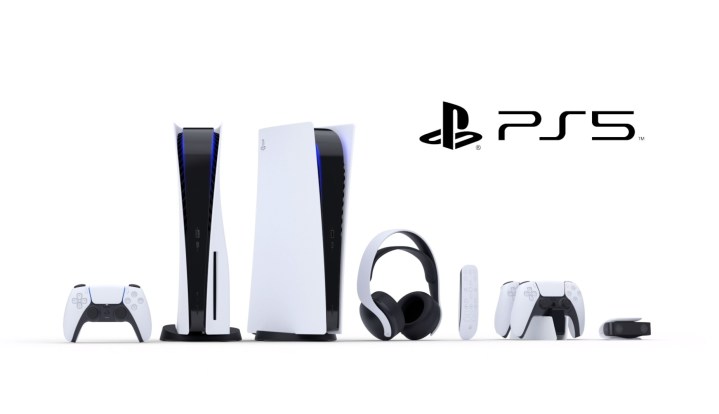
Comparing the Nintendo Switch to the PS5 is like comparing apples to oranges — both are vastly distinct and are meant to cater to different audiences. On one hand, you have the Nintendo Switch — an underpowered darling that focuses on portability, along with beloved indies and high-quality Nintendo games. On the other, you’ve got the PS5 — a system that will no doubt set a new benchmark for video games, delivering a breadth of top-tier Sony first-party games, fantastic offerings from third parties, and the power to showcase some of the best-looking visuals we’ve ever seen in video games.
Ultimately, we advise getting both, as each offers something the other doesn’t. You aren’t going to get quirky Nintendo games on the PS5 that you can take on the go, and you won’t get fantastic single-player PlayStation games on the Nintendo Switch. If your situation allows for it, grab both. Otherwise, pick the one that suits your needs based on game preference, price, and how important portability is.
Editors' Recommendations
- All cross-platform games (PS5, Xbox Series X, PS4, Xbox One, Switch, PC)
- PS5 Pro: news, rumored release date, price, and specs
- Fallout 4 is finally getting free Xbox Series X and PS5 upgrades
- Best gaming console deals: cheapest prices on PS5, Xbox S and X and Switch
- Best Nintendo Switch deals: consoles, games, and accessories



